Cute Watering Cans: Blending Functionality and Style
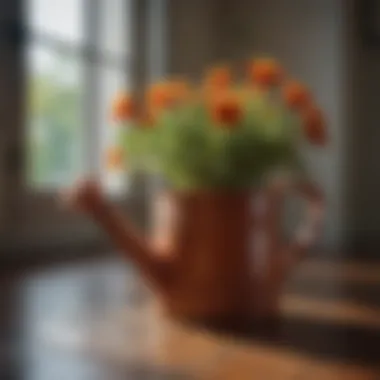

Intro
Selecting the right watering can for indoor plants may seem trivial. However, it plays a significant role in plant care and home aesthetics. Using an aesthetically pleasing watering can not only enhances your watering routine but also adds a decorative element to your interior. Homeowners, especially those with a penchant for indoor gardening, often seek solutions that marry function with design. This article aims to explore how to choose cute watering cans that serve purpose while complementing your home decor.
Design Inspirations
Aesthetic Trends in Indoor Design
Watering cans come in various designs that reflect modern trends. Minimalism is one such style that has gained prominence among house owners. Simple lines and solid colors create a calm ambiance. On the other hand, vintage or rustic designs appeal to those who cherish warmth in their spaces. Cute watering cans often feature unique shapes inspired by nature, like flowers or animals, making them delightful additions to any room.
Color Palettes and Themes
The color of a watering can can dramatically affect the overall look of your indoor space. Soft pastels bring a gentle touch, while vibrant colors add energy. Consider a watering can in shades that align with your existing room palette. It can tie the room together. Choose a watering can that reflects seasonal changes as well. Bright colors in summer can be substituted for earth tones in autumn, allowing your decor to evolve throughout the year.
Functional Elements
Practical Features to Look For
Choosing a watering can is not only about looks. Its functionality is crucial for an effective watering experience. A good watering can should have a well-designed spout. This design ensures even distribution of water, preventing over-saturation. Handles should be ergonomic to make lifting easier, especially when filling with water.
Sustainable Practices
The materials used in watering cans have an impact too. Plastic options are widely available, but they may not be the most sustainable choice. Consider options made from metal, such as galvanized steel, or biodegradable materials. These choices benefit your plants and contribute to environmental sustainability.
"Selecting the right watering can is more than a mere aesthetic choice; it's a commitment to nurturing your plants and home environment."
Maintenance and Care
Another practical aspect is maintenance. Cute watering cans can be just as functional as standard ones, but they should also be easy to clean. Regular maintenance ensures that plants do not get exposed to harmful residues. Keep in mind that certain materials might require special care, so read instructions before purchase. A well-maintained watering can prolongs its life and keeps your indoor plants healthy.
Closure
In summary, finding the perfect watering can involves balancing aesthetic appeal and practical utility. Cute designs, thoughtful material selection, and easy maintenance are all significant. Such considerations lead to a well-informed choice that enhances not only the well-being of your plants but also enriches your home atmosphere.
Prelude to Indoor Gardening
Indoor gardening has become a prevalent trend among homeowners and apartment dwellers alike. With the increase in urban living spaces, the importance of maintaining a personal green oasis cannot be overstated. Indoor gardens not only beautify living spaces but also serve various functional purposes. They enhance air quality, boost mood, and provide a sense of tranquility within the home. Choosing the right elements for indoor gardening is crucial. This includes selecting appropriate plants, suitable containers, and, importantly, functional yet attractive watering cans.
In this section, we will examine the historical context behind the rise of indoor gardening, along with the tangible benefits it offers to plant enthusiasts. Understanding these aspects prepares us for a deeper exploration into the specific tools, like watering cans, that contribute to the health and aesthetics of indoor gardens.
The Rise of Indoor Gardening
The trend towards indoor gardening surged notably during the COVID-19 pandemic. People searched for ways to connect with nature while being confined at home. This led to a renewed interest in houseplants, transforming spaces that were once stark into lively indoor jungles. Accessible resources, such as social media platforms, and communities have made it easier for newcomers to learn about the intricacies of plant care. Websites and forums on platforms like Reddit and Facebook have created vibrant communities, where individuals share tips and experiences.
It is also important to note that the rise of online shopping means that cute and functional watering cans are now just a click away. The design of these cans reflects the modern aesthetic that many homeowners prefer while maintaining functionality. More than ever, homeowners understand that indoor gardening is not just about plants; it's about creating an inviting ambiance within their spaces.
Benefits of Indoor Plants
The advantages of integrating indoor plants into home decor extend beyond visual appeal. Research indicates that plants improve air quality by removing toxins and producing oxygen. This leads to a healthier living environment. Additionally, being around greenery has been shown to enhance concentration and reduce stress. Some studies suggest that indoor gardening can improve overall well-being, contributing positively to an individual's mental health.
Moreover, indoor plants can balance humidity levels and temperature, making indoor spaces more comfortable. They also absorb sound, acting as natural sound barriers within bustling households or in urban settings. Beyond their health benefits, plants can serve as living decor, allowing homeowners to express their personal styles through the selection of plants, containers, and watering tools.
In summary, understanding the significance of indoor gardening lays the foundation for discussing the tools that aid in maintaining these green wonders. The next sections will delve into the specific features that make watering cans both practical and aesthetically pleasing.
The Role of Watering Cans
Watering cans play a crucial role in the indoor gardening experience. Their function extends beyond mere practicality; they are essential tools that affect plant health and enhance home aesthetics. Choosing the right watering can significantly contributes to the gardening process. It influences how much moisture plants receive and the ease with which gardeners can hydrate their indoor greens.
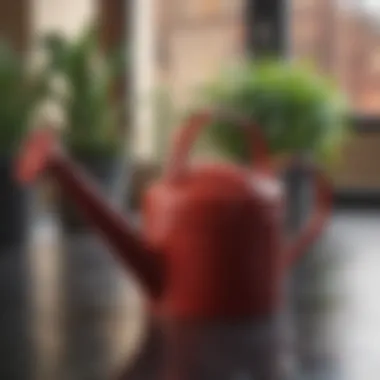
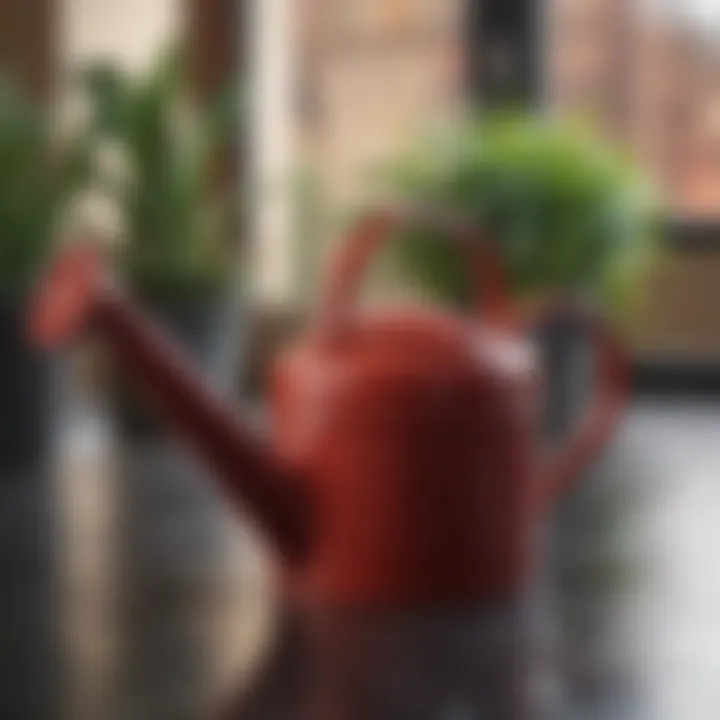
Why Choose the Right Watering Can
Selecting the correct watering can is not simply a matter of personal preference. The design and functionality can deeply impact watering efficiency. A well-designed watering can should provide precise control over water flow. This prevents overwatering, which can lead to root rot, and underwatering, which may cause wilting.
Considerations when choosing a watering can include:
- Comfort and ease of use: A lightweight can is easier to manage, especially during repeated use.
- Spout design: A long, narrow spout offers better precision, allowing water to reach the base of the plant without oversplashing.
- Capacity: Depending on the size of the indoor garden, selecting an adequate capacity avoids frequent refilling.
Choosing the right watering can means ensuring that your indoor plants thrive through adequate and controlled watering. It contributes to a more fulfilling indoor gardening experience.
Functionality vs. Aesthetics
The debate between functionality and aesthetics in watering cans is vital. While a gardener may gravitate towards a beautifully designed can that complements home decor, it is of utmost importance to consider its practical features.
Aesthetic choices should still prioritize functionality. For instance, a charming ceramic watering can may offer a stunning visual, but if it lacks an efficient spout or comfortable grip, it may frustrate the user.
On the other hand, functional watering cans that lack visual appeal may discourage a gardener from using them regularly.
"Finding the balance between functionality and aesthetics in watering cans leads to a more enjoyable and effective indoor gardening experience."
Design Elements of Cute Watering Cans
The design elements of cute watering cans play a crucial role in enhancing both the functionality and aesthetics of indoor gardening. These elements are not just about creating pleasing visuals but also about ensuring that watering cans are practical and convenient for everyday use. An attractive watering can can elevate the overall decor of a space, while its design features can improve user experience and plant care.
Color and Finish
Color and finish are fundamental aspects that contribute to a watering can's charm. Bright colors like green, yellow, or pastel shades can add a lively touch to indoor gardening. A glossy finish catches light beautifully, enhancing the beauty of the can. Matte finishes, on the other hand, provide a more muted, elegant appearance that may appeal to minimalist decor.
When selecting a color, consider the color scheme of your home. A matching watering can can act as an accessory, blending seamlessly with your decor. Alternatively, contrasting colors can create a striking focal point. Durable paint or coatings protect the can from wear and fading, ensuring it remains visually appealing over time.
Shape and Size Considerations
The shape and size of a watering can are not only vital for practical purposes but also influence its aesthetic appeal. A well-designed shape may feature curves or unique silhouettes that stand out on a shelf or windowsill. Form follows function, so the design should facilitate easy pouring and handling. A slim spout allows for precise watering, especially for smaller plants or delicate arrangements.
Size is also a key consideration. For larger indoor gardens, a bigger watering can reduces the need for constant refilling. However, for smaller spaces, a compact can is easier to store and manage. Finding a balance between form and function is essential.
Unique Design Features
Unique design features often set cute watering cans apart from conventional ones. Some cans may have whimsical elements like animal shapes or floral patterns, adding personality to your indoor gardening tools. Others might include practical additions like ergonomic handles or removable spouts for easy cleaning.
Innovative designs that allow multiple watering options can also enhance usability. For example, a can with an adjustable spout lets you control the flow of water depending on plant needs. Features that promote sustainability, such as recycled materials or biodegradable finishes, can appeal to eco-conscious users.
"The combination of aesthetic charm and practicality transforms a simple watering can into a statement piece in your home."
In summary, the design elements of cute watering cans significantly influence their functionality and appearance. By focusing on color, shape, size, and unique features, you can select a watering can that not only serves its purpose but also enriches your indoor environment.
Materials for Watering Cans
Choosing the right material for a watering can is significant. The material affects not just the aesthetics but also the functionality and durability of the product. Each type of material comes with its own set of benefits and considerations that can influence your watering experience and the care of your indoor plants.
Plastic Watering Cans
Plastic watering cans are popular for many reasons. They are lightweight, making them easy to handle, especially for those with many plants. The plastic is also resistant to rust and corrosion, which can be a downside with other materials. Additionally, plastic watering cans often come in a variety of colors and designs, allowing for a personal touch to your home’s décor.
However, there are some downsides. Plastic can degrade over time, especially when exposed to sunlight. This can lead to fading and brittleness, which might cause cracks. Also, not all plastics are environmentally friendly, so choosing a can made from recyclable materials is advisable.
Metal Watering Cans
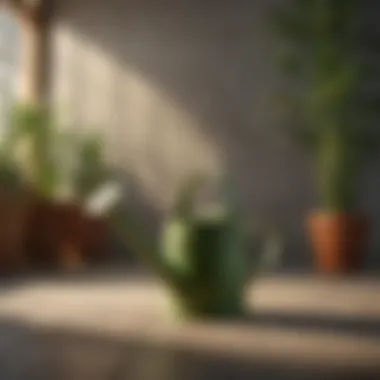
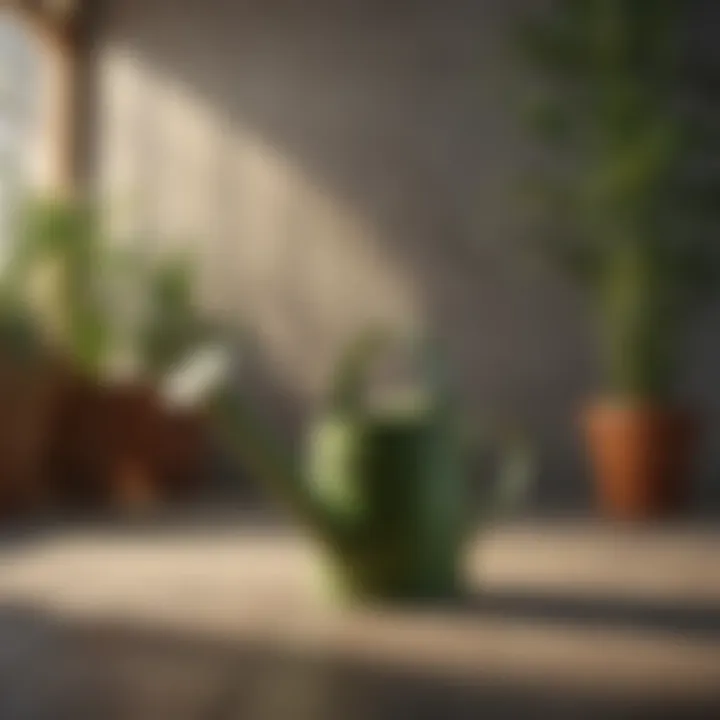
Metal watering cans offer a classic and sturdy option for plant care. Galvanized steel and aluminum are popular choices. They tend to have a long lifespan and resist UV damage, making them suitable for both indoor and outdoor usage.
The aesthetic of metal can complement a wide range of interiors. A shiny metal finish can bring a modern touch, while a weathered look can add rustic charm. However, metal cans can be heavier, especially when filled with water. This might be a consideration for some users. Additionally, some metals can rust if not properly cared for. Regular maintenance, like drying the can after use, can help prevent this.
Ceramic and Glass Options
Ceramic and glass watering cans are ideal for those who want to marry functionality with aesthetics. Both materials can be highly decorative and are often designed with unique aesthetics that serve as eye-catching decor.
Ceramic cans offer a variety of colors and patterns, which can blend seamlessly with any interior style. They are heavier, but this can provide stability while watering. Glass has the advantage of allowing you to see the water level, so you know when to refill.
However, both materials can be fragile, which is a major consideration for households with children or pets. They also typically come with a higher price point compared to plastic and metal options. Maintenance involves careful handling, and some users may prefer to reserve them for indoor use only.
In summary, when selecting a watering can, consider the material carefully. Plastic offers lightness and colorful options, metal provides durability but may add weight, while ceramic and glass bring elegance but require more caution. In this way, the right choice will enhance both your watering experience and the aesthetics of your home.
Practical Features of Indoor Watering Cans
When considering watering cans for indoor gardening, practical features are vital. These attributes are not just about function; they also contribute to the overall user experience. A well-designed watering can makes routine plant care more enjoyable and efficient.
Spout Design
The spout of a watering can significantly affects its usability. A narrow and long spout allows for precision when watering, enabling the user to target the root system without over-saturating the leaves. This design helps prevent leaf rot and mold, which are common issues in indoor plants. For smaller pots, a flexible spout can be advantageous as it can maneuver easily into tight spaces, ensuring every plant receives the proper amount of water.
Additionally, the shape of the spout should complement the style of the can. Some designs feature whimsical or artistic spout shapes that enhance aesthetics while providing functionality. A functional spout design combines practicality with visual appeal, marrying the purpose of the watering can with the decor of the room.
Capacity Considerations
Capacity is another critical factor when selecting a watering can for indoor plants. The size of the can should correspond to the number and type of plants being tended to. A smaller can, typically around one to two liters, is adequate for casual watering of a few small houseplants. However, for larger collections or larger pots, a can with a capacity of three liters or more can save time and effort, allowing for fewer trips to refill.
It's also essential to consider the weight of the can when filled with water. Heavier cans might be challenging to manage, especially for those who might struggle with lifting. Therefore, a balance between capacity and manageability is crucial.
Choosing the right capacity is fundamental for a seamless watering experience. Both spout design and capacity feature strongly influence the watering can’s practicality and its role in maintaining plant health.
Choosing the Right Watering Can for Your Space
Selecting the appropriate watering can is a nuanced process that involves assessing both functionality and visual appeal. For indoor plant enthusiasts, the watering can serves more than just a practical purpose. It can complement the aesthetics of a home while ensuring that plants receive adequate care. An informed choice enhances the overall experience of indoor gardening.
Understanding your specific needs, plant types, and personal style preferences is vital here. By evaluating these elements, homeowners can find a tool that fits seamlessly into their daily routines and home decor.
Assessing Your Plant Collection
When selecting a watering can, one must first consider the variety of plants being nurtured. Different plants have unique watering requirements. For example, succulents need less water than tropical plants. Therefore, understanding the specific needs of your collection is crucial. A smaller watering can with a narrow spout might be perfect for delicate plants or those in small pots, allowing for precision and minimizing overflow.
Key points to consider include:
- Plant Size: Larger plants may require a watering can with greater capacity.
- Watering Frequency: Plants with higher water demands benefit from a can that is easy to refill.
- Soil Type: Different soils may retain moisture differently, affecting how you water your plants.
Taking note of these details can simplify the choice of watering can and ensure that it aligns with plant care practices.
Matching Style with Home Decor
The visual aspect of a watering can is equally important. A watering can should serve as a decorative piece in your home, reflecting your personal style. When choosing a watering can, think about the color palette and design of your living space. A well-matched watering can can enhance the ambiance of an area and create a cohesive look.
Here are some considerations when matching a watering can with your home decor:
- Color: Choose colors that complement existing decor, whether vibrant or neutral.
- Material: If modern aesthetics dominate your space, consider stainless steel or plastic. For a rustic feel, ceramic or terracotta might be better.
- Shape: The design (tall, short, ornate, or simple) should resonate with your home’s overall style.
A watering can can be an extension of your personal style, seamlessly blending functionality with aesthetics.
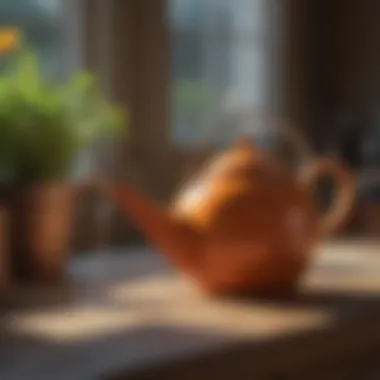
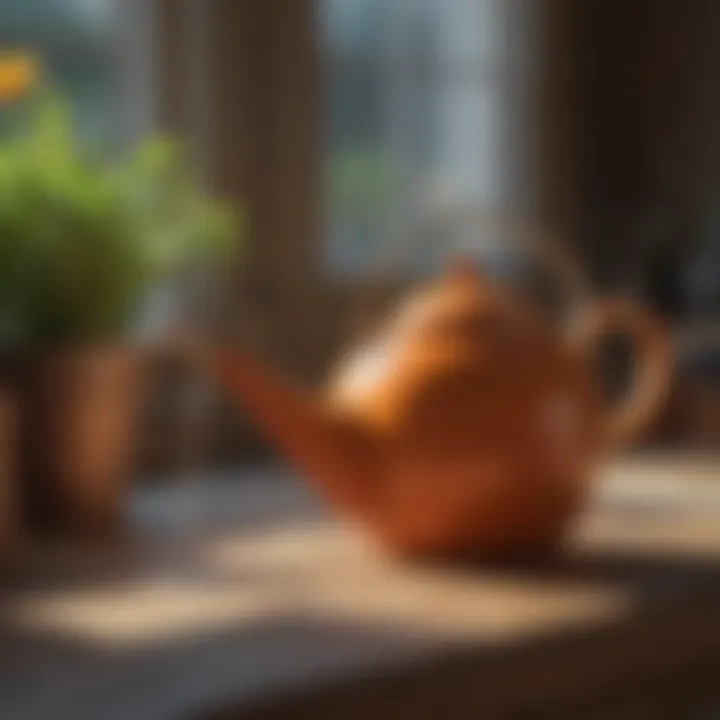
"A perfect watering can balances the needs of both your plants and your living space."
By carefully considering your plant collection and matching style with decor, the right watering can for your space becomes clear. Such attention to detail enriches both the plant care experience and the home environment.
Maintenance and Care for Watering Cans
Caring for your watering can is a crucial aspect that is often overlooked in the context of indoor gardening. Maintenance and care ensure that your watering can remains functional and visually appealing, supporting the overall health of your plants. A well-cared-for watering can not only serves its purpose but also enhances the aesthetic of your indoor space. Regular cleaning, proper storage, and attention to materials are key factors to consider.
Cleaning Practices
Keeping your watering can clean is essential for the health of your indoor plants. Dirt, algae, and lime deposits can accumulate inside and affect water quality. Here are some cleaning practices to consider:
- Emptying the Can: Always make sure to empty the can completely before cleaning.
- Using Mild Soap: A gentle soap solution can be effective. Avoid harsh chemicals that might linger and harm the plants.
- Soaking and Scrubbing: For stubborn stains, soak the can for a while and use a sponge or brush to scrub the interior and exterior. Pay attention to the spout, where buildup can occur.
- Rinsing Thoroughly: After cleaning, rinse very well to remove any soap residue to ensure that it does not interfere with your plants' watering.
- Drying Properly: Allow the watering can to dry completely before storing it. This helps prevent mold or mildew.
Storage Solutions
Proper storage of your watering can can extend its lifespan and maintain its aesthetic appeal. Here are some practical storage solutions:
- Indoor Placement: Keep the watering can in a designated spot that is easily accessible, yet blends smoothly with your home decor.
- Hanging Solutions: If space is limited, consider installing hooks to hang the watering can. This option saves space and allows for a decorative display.
- Avoid Direct Sunlight: Store away from direct sunlight, especially for plastic cans, as prolonged exposure can lead to fading and cracking.
- Seasonal Rotation: If you have multiple can styles, rotate their storage based on seasons. This allows for both usage and a refreshing change in decor.
- Dedicated Containers: Use decorative bins or baskets to store watering cans along with other gardening supplies. This keeps your space organized and neat.
Following these maintenance and care practices will ensure your watering can remains both functional and a charming part of your indoor gardening setup.
Sustainable Practices in Plant Care
Sustainability has become an essential consideration in various aspects of our lives, including plant care. In the context of indoor gardening, sustainable practices are vital for maintaining healthy plants while also being kind to the environment. Adopting sustainable methods can lead to better resources management, reduced environmental impact, and enhanced plant health. It encourages practices that minimize waste and promote the longevity of both the plants and the materials used to care for them.
Taking a responsible approach in maintaining indoor plants means being conscious about water usage and the materials selected for tools. This section emphasizes how cute watering cans can embody these sustainable practices, demonstrating that functionality and aesthetics can coexist harmoniously.
Water Conservation Strategies
Implementing effective water conservation strategies is key for indoor gardening enthusiasts. Here are several practical methods to ensure water is used efficiently:
- Watering Frequency: Understand the specific needs of different plant species. For example, succulents require less watering compared to ferns. This knowledge can minimize overwatering and conserve resources.
- Soil Type: Using well-draining soils can limit the amount of water needed. Organic soils retain moisture while allowing excess to drain, making it easier to maintain proper hydration levels for plants.
- Rainwater Collection: A unique way to conserve water is to collect and utilize rainwater for indoor plants. This minimizes reliance on tap water and reduces utility costs.
- Efficient Tools: Using a watering can with a precise spout design can target the roots directly, making the watering process more efficient and preventing wastage.
"Every drop counts; conserving water is a responsibility we all share while caring for our indoor plants."
Choosing Eco-Friendly Materials
Selecting eco-friendly materials for watering cans not only supports sustainable plant care but also encourages responsible consumer choices. Here are some materials and their benefits:
- Recycled Plastic: Watering cans made from recycled plastic reduce waste. They are lightweight and often come in vibrant colors, making them aesthetically pleasing.
- Stainless Steel: This material is durable and can be used for prolonged periods, reducing the need for frequent replacements. Stainless steel is also recyclable at the end of its life cycle.
- Bamboo and Wood: Using natural materials such as bamboo can add an earthy aesthetic while being biodegradable. They may not be as common in massive production but serve as attractive and sustainable options.
- Ceramic: While heavier, ceramic watering cans are often made with local materials and can be reused indefinitely, making them a sustainable choice as well.
Choosing eco-friendly materials means considering their full lifecycle, from production to disposal. By selecting sustainable watering cans, individuals are contributing to a more responsible approach towards indoor gardening. The impacts of these choices extend beyond personal satisfaction to encompass broader environmental well-being.
The End and Final Thoughts
The selection of a watering can is not merely about its utility; it entwines function and beauty that enrich indoor gardening experience. A cute watering can serves several purposes: it helps maintain hydration for plants while enhancing the overall aesthetics of your home. The way a watering can looks can be just as important as how well it performs its duties. With thoughtful selection, one can elevate both plant health and home decor simultaneously.
When deliberating on a watering can, factors such as design, material, and usability must be taken into account. Functionality is paramount; plants need to be watered efficiently, and the right can can make this task seamless. Yet aesthetics cannot be overlooked. A beautifully designed watering can serves as a decorative accent, complementing the interior design and bringing joy to the mundane task of maintaining indoor plants. This dual role emphasizes the necessity of choosing wisely.
"The right watering can nurtures not just your plants but also your living space's character."
In the end, a carefully selected watering can reflects personal style and commitment to indoor gardening. It is essential to consider both functionality and aesthetics in making this choice. Simple yet effective, a watering can can be an everyday object that adds character and charm to your home.
Recap of Key Points
- Function and Beauty: Selecting a watering can involves balancing practicality with aesthetics.
- Effective Design Elements: Consider color, shape, and unique features that enhance the watering experience.
- Material Choices: Understand the benefits of different materials, including plastic, metal, and ceramic, in your selection.
- Everyday Impact: A cute watering can not only serves functional purposes but also elevates the visual appeal of indoor plants.
Encouragement for Thoughtful Choices
When selecting a watering can, embrace the opportunity to express personal style. Look for designs that resonate with your individual taste and complement your existing decor. A cute watering can can be a conversation starter or a simple pleasure in your daily routine. Remember that the right choice can influence not just the health of your plants but also your enjoyment of indoor gardening.
As you curate your plant collection, make the watering can an intentional part of your decor. Choose thoughtfully and recognize that this element has the power to enhance your gardening journey and your home environment.















